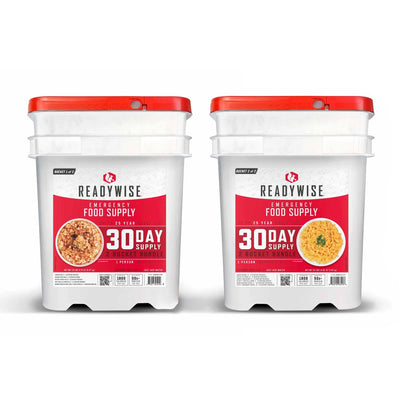Emergency Preparedness a Must, Even for Disaster Pros
Former Marine Jeff Byard knows a little something about disasters. After 16 years working in emergency response in Alabama, he rose up to become the Associate Administrator for the Office of Response and Recovery at the Federal Emergency Management Administration, where he led federal responses to countless national events, including the hurricane seasons of 2017 and 2018. Then, in early 2020, Byard joined Team Rubicon as VP of Government Relations and Emergency Management. Not only does he know about the politics of disaster, he knows how it affects people in very real ways—and how they might avoid some of the pain.
“There is no question, people who take the time to have a plan and prepare are in a better position for recovery,” said Byard, who is currently responding to Hurricane Laura in Louisiana.
Those people he’s referring to include not just the general public, but also the very people first on the scene of a disaster, like Team Rubicon Greyshirts.
“If we really want to punch disasters in the face, the time to act is now. Team Rubicon’s mission is to help our communities respond and recover on their worst day,” says Byard. “Greyshirts must set the example for our communities. We need to create a culture of preparedness in this country and Team Rubicon—with its 130,000 Greyshirts across the nation—can be the catalyst for that change.”
Byard isn’t the only Team Rubicon volunteer who knows a thing or two about disaster preparation. The organization is full of first responders and local emergency management professionals. Three Greyshirts who work in emergency management shared their professional and practical tips.
GET INFORMED
It’s not just important to be prepared for any disaster, people should be specifically prepared for the kinds of disaster most likely to occur in their area. While most disaster preparedness plans will be similar, but it is a good idea to figure out if you are most likely to experience floods, tornadoes, wildfires, earthquakes, or a winter bomb cyclone, and tailor your kit accordingly. You might not put heavy blankets or a shovel in your kit if you’re in a wildfire zone, but you would in an avalanche area.
Emergencies begin and end at the local level according to Scott Kensinger, emergency management coordinator for Winchester, Virginia, so focusing on the likely risks specific to your community is a critical first step.
Emergency management pros also encourage people to determine how local emergency officials will inform them of imminent danger. Make sure you are signed up to receive emergency alerts and warnings from your community. And, ensure that you haven’t disabled Wireless Emergency Alerts on your phone or with your provider.
Greyshirts, first responders, and others might want to take it a step further and download the FEMA app or sign up for FEMA text messages—including preparedness tips.
TAILOR YOUR PLAN
Develop a plan tailored to your risk, your family, and your community. Communication is key, and it can be the first thing to fail when disaster strikes. Disasters don’t always happen when everyone is gathered together, either. Think about how you manage when you are at work 30 miles from where the kids are at school.
“Any disaster is easy to react to when the whole family is home,” says Greyshirt Kevin Kugel, director of the Providence, Rhode Island Emergency Management Agency. “But when happens when the kids are all at school, Mom’s at work and Dad is at the dentist when the tornado rolls through town?”
Talk with your family about what you will you do in the first hour or two when disaster strikes. Establish a place you will meet, or identify an out-of-state friend, a family member—even a fellow Greyshirt—with whom each family member can connect, advises Sarah Gamblin-Luig, deputy commissioner for the St. Louis, Missouri. City Emergency Management Agency. Then, think beyond the immediate moment to the following days and weeks if you are without power or must relocate.
Having a communication plan with multiple options is also important because interruptions to power or networks are likely. “Knowing that there will likely be multiple points of failure following a disaster should be reason enough to build redundancy into your plans,” says Gamblin-Luig. Because completing a call over a crowded network will quickly become impossible, she recommends trying text instead. She also suggests marking yourself safe using Facebook’s Safety Check or the Red Cross’s Safe and Well program.
And, for responders who might be leaving their family while they respond to an emergency in the community, the Greyshirts had advice: “Responders must prepare just as anyone in their community would, but they also need to prepare their families as best they can to execute the plan without them. We must plan (and practice) as though we will have been called away to work,” says Gamblin-Luig.
“As first responders, we take the so-called oath to protect the community. I have always had a sense of duty that drives me. With that said, I have always ensured my family was in a good position and could fend for themselves while I was gone,” says Kensinger.
Every good emergency preparedness plan is layered and should include a household communication plan, a plan for an evacuation route, and even a shelter plan. Ready.gov has plenty of resources to guide you through the planning process.
BUILD AN EMERGENCY KIT
Think about the most likely risks you face, in your particular community, and what you would need to take care of yourself and your loved ones (including pets if you have them) for several days. It’s easy to start slow by buying an item or two every time you go to the store, suggests Kuger. Think about non-perishable food, extra water, toilet paper (perhaps the hardest thing to find right now) diapers, formula and medications. Don’t forget a few toys and comfort objects for children, and pet food and leashes for the furry family members. Ready.gov also offers an itemized list of items to consider.
Greyshirts and first responders might keep some things in their kits that other citizens would not—like the tourniquet Kensinger could deploy on himself if needed. He also keeps an MRE, flashlight, knife, strike firestarter, bandana, and spare socks in his kit.
“My advice is to look in your kit and touch each item and say what and when would I have a need for this item, is there something else in the kit that could serve the same role. Know how to use each item, think through possible scenarios, and determine what would be needed,” he says.
COPY OR DIGITIZE IMPORTANT RECORDS
One thing many disaster kits lack is critical records. It’s easy to copy these and keep them in your kit or even scan them and keep them digitally. Insurance information, medical records and contact lists are a good place to start.
PACK YOUR GO BAG
While you are making your preparedness plan and kit, don’t forget to keep your Go Bag ready. These Greyshirt EM professionals say they keep their bags packed at all times, and throw a few things in at the last minute tailored to the type of operation.
“My Go Bag does reflect that I usually fill some sort of emergency management or communications role, so I always carry a power strip, battery back-up packs, charging cables, a cell phone tripod/holder, and my trusty Incident Command System pocket guide,” says Gamblin-Luig. “I also carry a picture of my cat to keep near my bunk as my little piece of home away from home to see every night before lights out.”
Added plus: Having your Go Bag handy means you’ll be even more prepared if you end up deploying to an emergency in your own community.
Taking these steps will make you and your family better able to respond to disasters that can occur and may spur you to take actions to mitigate your risk. Having a pre-determined meeting place can alleviate much of the anxiety that can occur when family members have trouble getting in touch with each other. And being able to pull up important documents you’ve stored will make recovery easier. Communities will weather disasters better if they prepare today. As Greyshirts, preparedness should start with you.
About the Author:
Connie McNamara is the Communications Lead for the Mighty Northeast Territory. She has been a communications professional for more than 30 years and is passionate about preparedness.

















































































